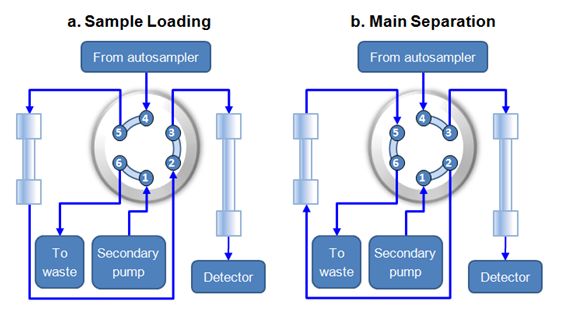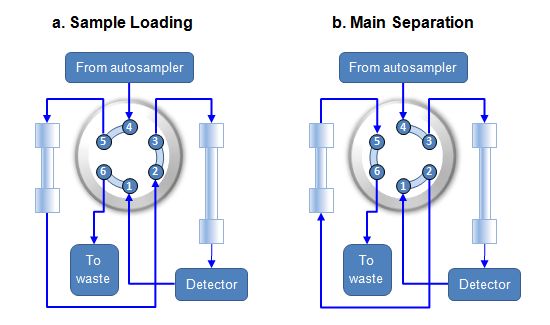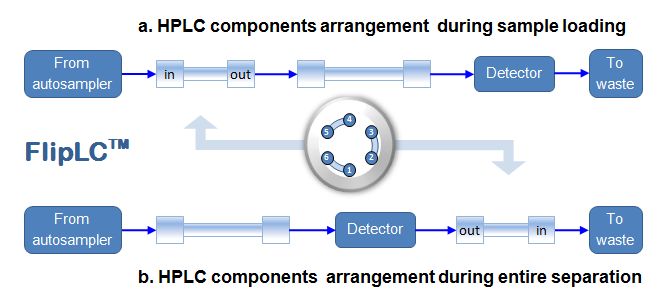A New Method to Measure Charged Analytes in Complex Mixtures
Measuring by HPLC a particular component of complex samples such as natural products, body fluids, and environmental probes is complicated due to interference from other components. Different sample matrices require different sample cleaning procedures prior to separation, and as a result, one procedure cannot be used across a variety of products. The column’s operating life is usually short, even with sample cleaning due to irreversibly retained contaminants. Thus, long cleaning procedures, guard columns, and expensive and complex compound-specific detection techniques such as MS are often required. An example of such problems appear in the measuring of nitrates. All of the existing methods are complicated and take significant time to execute. Usually, the methods are specific only for the particular sample type.
FlipLC™ is an alternative method to avoid the interference of most of the contaminants by the use of an isolation column and a high pressure switching valve, before the separation column. This method allows sample cleaning and analyte separation in one automated process. The isolation column and separation column should have orthogonal retention characteristics to operate efficiently in this setup. Mixed-mode columns with reverse phase and ion-exchange characteristics were used in this analysis. The setting below employs a high pressure 6-port, 2-position switching valve which is placed between an autosampler and analytical column, and actuated by the chromatography system by a defined time after the injection.
An additional isolation column is connected to the valve’s ports and allows the switch of the position of this column in the chromatography flow path. In this setup, a sample is introduced to the isolation column first. The isolation column passes analytes through and retains the late eluted components of the sample. When the valve is actuated at a defined time after the injection (this time depends on the nature of the analyte) the whole plumbing system of the setting changed without flow interruption. After the valve switching (takes fraction of a second), the isolation column flipped in reverse relative to the mobile phase flow and became connected to the detector outlet. The late eluted components, while still in the isolation column, are back-flushed to waste by the flow coming from the detector outlet. The original plumbing arrangement restored prior to next injection.
Many biologically important compounds can be analyzed directly in human serum/plasma. Before, the restrictive access media (RAM) columns were used which trap small molecules on RAM columns while plasma proteins do not retain. Then, small molecules can be analyzed on a regular analytical RP column with UV or MS detector. However, this technique does not work for polar molecules. They do not retain on RAM columns with hydrophobic interior. This becomes an easy task with FlipLC. The serum proteins get trapped on the flip Primesep SB column at low organic mobile phase, and polar analytes pass through directly to the analytical column. After valve switching, the proteins get flushed out in reverse direction from the Flip column by a secondary pump using solvent with higher organic concentration. In Mass Spec (MS) detection, setting the mobile phase gets evaporated in the detector and in order to flush the Flip column, an additional isocratic pump would be required (see diagram below).

As a result, a good isolated peak of a polar analyte was obtained with serum proteins removed from the sample. Because of the efficiency of the analyte isolation, the final method can be done in about 5 minutes.
One useful application presented is analysis of serotonin in human serum. This setting eliminates the need for complex sample cleaning prior to the analysis, provides high analyte(s) recovery, and eliminates the need for SPE cartridges and liquid handling equipment. The method is fully compatible with MS and UV detection.
These results were obtained due to the unique properties of mixed-mode columns, which retain compounds by both reverse phase (RP) and ion-exchange (IE) mechanisms.
FlipLC has been used for measuring different charged compounds in complex mixtures.
The list includes:
- Nitrate concentration in food and other types of complex samples
- Vitamin C content in fruits and vitamin supplements
- Glutamine and other amino acids in nutritional supplements
- Metabisulfite in vine
- Direct analysis of polar compounds in serum
- HPLC Determination of Tramadol in Human Plasma and Urine Samples with FlipLC system
- HPLC Determination of Ascorbic Acid in Strawberry Juice
- Iodine in thyroid glands tissue
- Dopamine in biological fluids
If the sample is a complicated mixture consisting of many different chemicals, it is hard to isolate a particular analyte without complicated sample preparation. Our new FlipLC method addresses this problem. It consists of an analytical column connected by a valve to an isolation (flip) column which retains charged analytes orthogonally relative to the analytical column. This method eliminates most of the interfering components from the chromatogram, shortens the analysis time, and increases the lifetime of the analytical columns. FlipLC™ allows for the analysis of a targeted compound found within a variety of complex samples using a single chromatography method. Due to the unique property of mixed-mode columns to retain molecules by RP and IE mechanism, many polar charged analytes can retain and quantified with simple methods without ion-pairing reagents.



